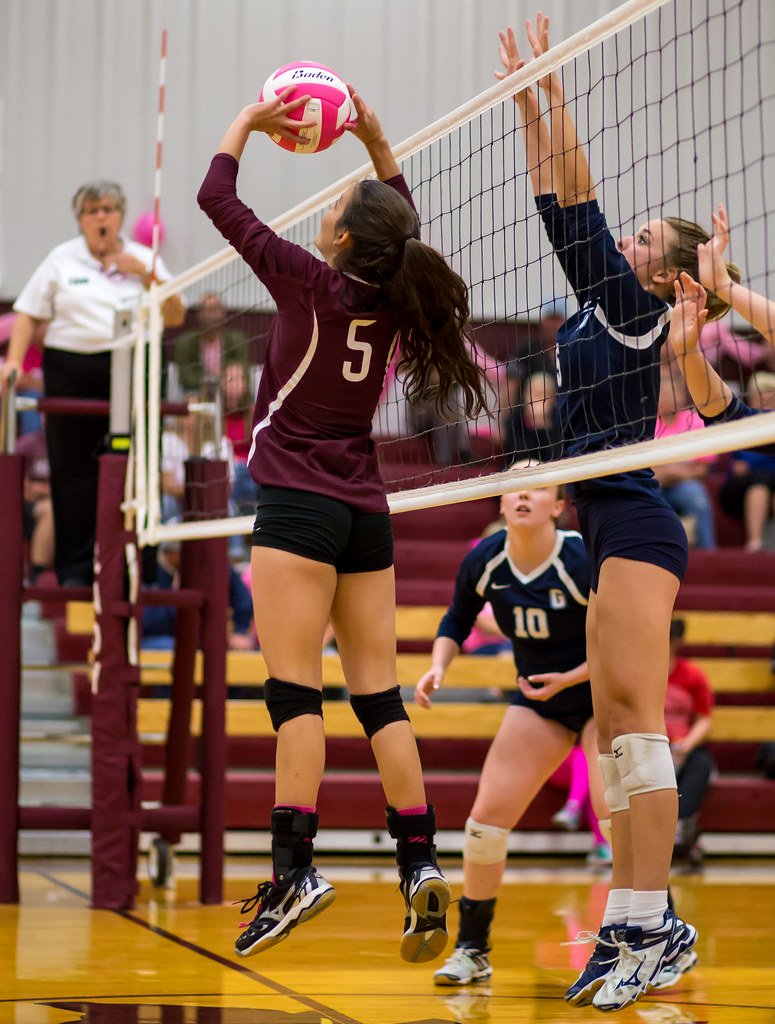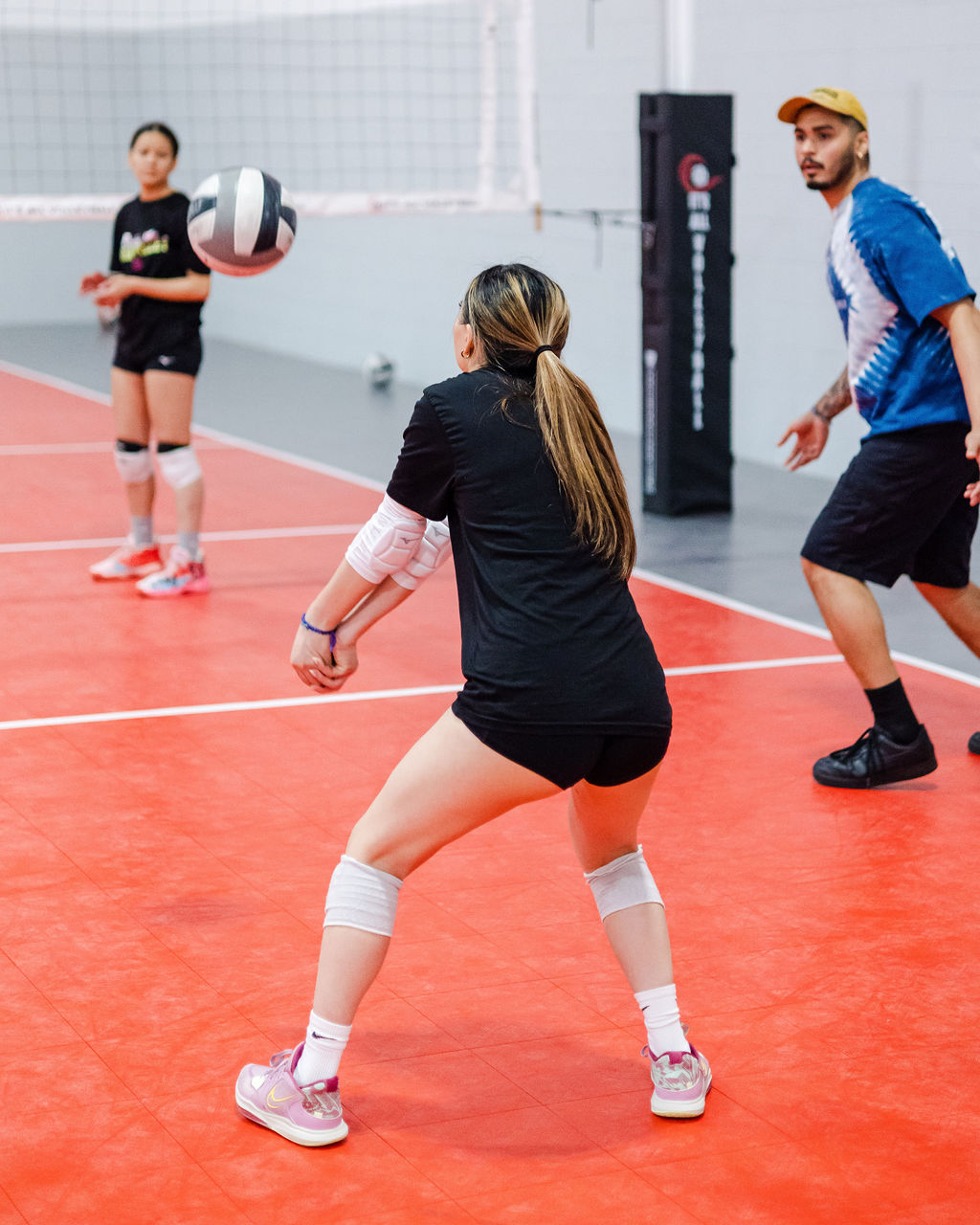- Improve Your Volleyball with Coach April
- High School Varsity Volleyball
- The Volleyball Block
The Volleyball Block:
Improve Defensive Skills With Tips on Blocking
Improve your volleyball block and front row defensive skills by focusing on good footwork movement along the net and great body control when blocking.
The block is your squad's first line of defense against an opposing team’s outside hitters or any attack hits by their players in the middle blocker position.
The block in volleyball is one of the most dynamic and most exciting parts of this crazy game we love to play.
The Volleyball Block
Tips on Volleyball Blocking
At the beginning of a rally, after the whistle blows and your team serves the ball into the opposing team's court, every front row player on your team should be focused on keeping your opponent from spiking the ball down onto your court's floor.
Watch what "BSBH" means!
Once the ball hits the floor or hits a blocker's hands and goes out of bounds, that's a point for the opposing team, and you don't want that to happen.
Knowing how to put up an effective volleyball block will keep the opposing team from scoring points from their front row while they are on offense.
At the beginning of a rally, if your team is on defense, after the referee blows their whistle and your team serves the ball into the other team's court, the players in zone 2, zone 3 and zone 4 on your side should be laser focused on keeping your opponent from spiking the ball across the net and into your court.
In order to do that the front row players need to start by checking their upper and lower body blocking ready position so that they can be as efficient and as fast as they can.
So that when they move along the net also known as moving laterally, which means from side-to-side along the net before jumping to block a ball their opponent is trying to hit, they are in a well balanced position to stop the ball.
As a blocker, you need to position yourself in a way to create a barrier using your arms and hands to deflect any hit or spike attempts from an opposing team's spiker back into their court.
 Volleyball Block: You need to position yourself to create a barrier using your arms and hands to deflect any hit or spike attempts from an opposing spiker back into their court. (Aversen)
Volleyball Block: You need to position yourself to create a barrier using your arms and hands to deflect any hit or spike attempts from an opposing spiker back into their court. (Aversen)You are in fact trying to make yourself into a human wall, and that wall should prevent an outside hitter or middle hitter or back row attacker from the team on the other side of the net from hitting the ball onto your side of the court.
Tips on Volleyball Blocking:
What Should Your Feet, Knees and Lower Body Be Doing?
 As a blocker you want to start in a balanced position with your feet so that they are parallel to each other. (Ralph Aversen)
As a blocker you want to start in a balanced position with your feet so that they are parallel to each other. (Ralph Aversen)As always when I coach volleyball skills to players, I like to start at the bottom, with what you're supposed to do with your feet.
What should your feet be doing and where should they be positioned?
- You want to start in a balanced position with your feet so that they are parallel to each other.
Olympic gold medalist, David Lee gives a master class on the block in volleyball.
- They should be perpendicular to the net so that you can maintain a balanced position that will allow you to move quickly to your right, to your left or backwards off the net to get back in defense or to transition so you can begin your spike approach if necessary.
This is also called a "loaded" position.
The ideal position for your lower body is to have your hips, midsection and upper body “squared to the net.”
When you hear the phrase squared to the net, it means that your body is completely parallel to the net. When all parts of your body are facing the net then your body is squared up to the net.
Do You Follow Me on Pinterest?
 Private or semiprivate volleyball indoor/sand lessons are an excellent way for young Las Vegas high school volleyball players to quickly improve their individual skills through a private or semi-private coaching experience.
These lessons are conducted by former pro volleyball player, former USA Volleyball High Performance instructor and Evaluator and Tstreet Vegas 18s head Coach April Chapple on a weekly basis.
Sign up now!
Private or semiprivate volleyball indoor/sand lessons are an excellent way for young Las Vegas high school volleyball players to quickly improve their individual skills through a private or semi-private coaching experience.
These lessons are conducted by former pro volleyball player, former USA Volleyball High Performance instructor and Evaluator and Tstreet Vegas 18s head Coach April Chapple on a weekly basis.
Sign up now!Follow me on Pinterest Volleybragswag to improve your game even faster!
I share alot of individual, partner and easy-to-do volleyball serving drills we do in class with my followers.
Many of these volleyball practice drills you can do at home by yourself or try at your next practice with your teammates.
If you're a B team or JV player trying to make varsity next year...your goal should be to complete 1000 reps a day of at least three of the basic skills on your own...volleyball passing, serving and setting should be at the top of the list.
How To Play Volleyball:
Where Do You Go From Here?
We know where you need to go now! Here are three options:
- Learn more about Blocking by clicking one of the links in the Related Links below.
- Follow the suggested reading on our Sitemap page Learning How To Play (Sitemap)
- Or visit the pages in the How to Play Volleyball section in the drop down menu at the top of the page to get started.
- Before leaving this page Say "Hi" to Mr G.B Blash, the Bear, wearing the #11 jersey below. "G.B" aka "Great Big" is the starting middle blocker for the All Beast VolleyBragSwag All Star team.
If your athlete struggles with consistent serve receive, gets subbed out, or is overlooked for playing time—this is the fix you’ve been looking for.

Struggling with passing consistency?
I help talented passers tired of getting pulled from games because of inconsistent serve receive skills BUILD passing confidence without expensive private lessons using the same 3-step system that's helped dozens of my athletes get recruited.
Download my eBook for $17.99 and start building the passing confidence that keeps you on the court—and gets you seen by college coaches.
From Lady Vol to Legend: Coach April Produces Powerful Passionate Players...is that you?
Congratulations to my seven Boys-18s Vegas Volley club players who played in two state championship finals yesterday, the 3A and 5A State champinship finals at Sunrise Mountain High School.
TOURNAMENT CHAMPIONS!
A-1 Vegas Volley VBC
In It To Win It Tournament
May 2 - 4, 2025 Tournament
Gold Medalists
18s Premier Division
 Making A-1 Vegas Volleyball history as the very first TOURNAMENT CHAMPIONS! In the In It To Win It Tournament,
May 2-4, 2025 Tournament,
A-1 Vegas Volleyball Club
Gold Medalists, 18s Premier Division
Making A-1 Vegas Volleyball history as the very first TOURNAMENT CHAMPIONS! In the In It To Win It Tournament,
May 2-4, 2025 Tournament,
A-1 Vegas Volleyball Club
Gold Medalists, 18s Premier DivisionWhat Are You Looking For?

Hi there!
Thanks for stopping by. Hope you learned something today that will help you reach your volleyball goals.
Be sure to subscribe to my email newsletter so you can learn more each week!
Stay strong! Stay motivated!
-Coach April

SUSCRIBE
to my email newsletter below!
Vegas Volleyball's Unsung Heroes: Celebrating Moms with Peace Love Volleyball Shirts
Ready to energize your volleyball mom journey?
Subscribe to my 'Producing Powerful Passionate Peaceful Players' email list above on ImproveYourVolley.com.
You'll receive energy-boosting tips, exclusive insights from me, Coach April Chapple on maintaining momentum in volleyball.
Let's power up the Vegas volleyball scene together!
Recent Articles
-
Elite Volleyball Training: How I Produce Powerful Peaceful Players
Aug 31, 25 03:08 PM
Coach April's elite volleyball training in Las Vegas offers professional level techniques, college-prep skill analysis and proven results for serious athletes. -
Understanding the Let Serve Rule in Volleyball and Questions Answered
Aug 30, 25 04:47 PM
Learn basic let serve volleyball service rules and get your serving questions answered like can a libero serve? Where does a server serve from? -
Setter Volleyball Drills - How To Improve Your Setting Skills at Home
Aug 29, 25 05:26 PM
These setter volleyball drills are great for setters and non setters who need to work on getting soft setter hands and setting repetition touches.














































